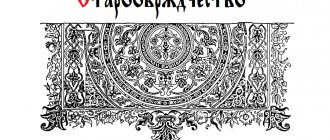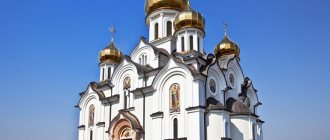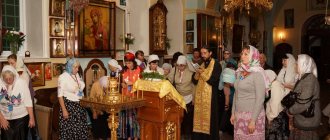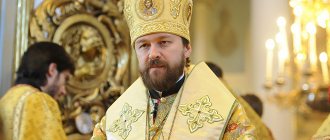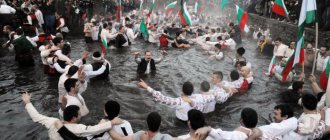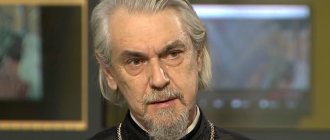Orthodox Church: structure, areas of activity, sources of funding
In the Old Russian state, the church was headed by the Kiev Metropolitan, appointed from Constantinople or by the Prince of Kyiv, followed by the election of bishops at a council.
In large cities, bishops were in charge of all church affairs. Hierarchs could own lands, cities, and villages. The church had its own court and legislation, which made it possible to intervene in all aspects of the life of its parishioners. The power of the church was based on its rapidly growing material income. Vladimir Svyatoslavovich established the “tithe”.
Definition 1
“Tith” is the deduction of a tenth of the prince’s income to the benefit of the church.
Relying on material wealth, the church acquired influence on political and economic life, on the life of the population. She sought to act as a guarantor of inter-princely agreements, fixed by the “kiss of the cross”, intervened in negotiations, and church representatives often took on the role of ambassadors.
Help with student work on the topic The Role of the Church in the Old Russian State
Coursework 450 ₽ Essay 280 ₽ Test paper 240 ₽
Get completed work or consultation with a specialist on your educational project Find out the cost
The Orthodox Church used various methods to preach its doctrine and establish authority. A major role in this was played by the construction of temples, the architectural form and internal painting of which symbolized the “earthly” and “heavenly” worlds. For the purpose of religious influence on human consciousness, services and rituals were performed. Prayers for recovery, victory over enemies, and salvation from natural disasters were held in churches, sermons and teachings were delivered. With the help of confession, churchmen penetrated into the inner world of parishioners, influenced their actions and found out information about plans against the church, the ruling class and the social system.
Despite the fact that during the period of feudal fragmentation Christianity had already embraced most of the population, even among the nobility there was disdain for religion and disrespect for the clergy. Among the people, resistance to Christianity was even greater.
Church leaders tried to strengthen the position of the church; it turned into a source of Christianization of other peoples. At the same time, there was an interpenetration of individual elements of religious ideology and cult as a result of the broad interrelations of Kievan Rus.
Do you need to select scientific articles for your academic work? Specify a topic and receive a response in 15 minutes get help
Under Vladimir, the church was in charge of some worldly affairs related to state interests. The Church received jurisdiction over all Christians (family matters, cases of “violation of the sanctity and inviolability of Christian churches and symbols,” apostasy, “offensive moral feelings”). Also, a special society was placed under church care, separated from the flock - almshouse people. They included:
- white clergy with families;
- clergy;
- monks;
- priest widows and adult priests;
- wanderers;
- bread;
- people staying in hospices and hospitals, and those who served them;
- “inflated people”, beggars, outcasts, the population of church lands.
“Russian Reformation”: church schism in Russia (part I)
After the capture of Constantinople by the Ottoman Turks in 1453 and the end of existence
The Byzantine Empire - the centuries-old stronghold of the Orthodox Church, the only independent power whose population professed predominantly Orthodoxy, and the ruler himself was Orthodox, remained the Moscow State - early Russia. The Russian Orthodox Church developed the concept that Moscow is the “Third Rome”: at first Rome (i.e., the Roman Empire) was the stronghold of the Christian faith, but fell under the blows of the conquerors because it was carried away by the religious distortions of the popes; The “second Rome” was Constantinople, but it was mired in luxury and debauchery, as a result of which it was conquered by the Turks. The Russian Church explained the fall of Constantinople, missionaries from which in the 10th century. and turned Rus' into
Christianity, divine punishment and proclaimed Russia, in which Christian morality was zealously guarded, the only heir of the “true faith”, the Russian sovereign - the divine vicegerent, the world defender of Orthodoxy. The Russian Orthodox Church, whose spiritual authority was undeniable in Russia at that time, was an extremely influential structure in the Moscow state, and although the church hierarchs humbly bowed their heads before the Russian monarch as the only “correct” Christian sovereign in the world, the influence of the church could shake the will and all the highest secular dignitaries, and the Russian Tsar himself. The Church actively formed both among the people and in government circles the political position that Russia is a kind of “missionary power”, which is charged from above with the duty to protect the Orthodox faith and Orthodox Christians throughout the world, and the Russian sovereign is the world patron of all co-religionists. In the era of the Middle Ages - the beginning of the New Time, the entire worldview of people was determined by the teachings of their religion, and any person considered only his own faith to be true and correct, he perceived only his fellow believers as full-fledged people, therefore the Moscow state considered itself a global bastion of truth and virtue. This strengthened the authority of the Russian Orthodox Church in the eyes of the flock, the Russian sovereign in the eyes of his subjects, and encouraged the Moscow state to seek ways to its rise in the international arena and territorial expansion. Having begun its territorial expansion with the annexation in the 16th century. lands of the Volga region, which previously belonged to the khans - the rulers of the states formed as a result of the collapse of the Golden Horde (of which Rus' itself was once a vassal), by the 40s. XVII century Russia established control over Western Siberia and the main river routes of Eastern Siberia, where Russian wooden fortresses - forts - were built, with settlements attached to them, secular and church administrations were established, and missions were opened to convert the indigenous population to Orthodoxy.
Since the Russian Orthodox Church was considered a “daughter” of Constantinople (it completely separated from that only in 1589, when it began to elect its own patriarch - the supreme head of the church), traditionally Russian priests, when compiling ritual books, were guided by Byzantine models. However, the remoteness of Russia from Constantinople did not contribute either to the spread of church literacy in it, or to sufficiently regular contacts with the Constantinople clergy, who kept ancient church manuscripts starting from the most ancient basics. The Moscow state did not have enough educated priests who were fluent in the Greek language, and representatives of the Church of Constantinople could not come to Russia for a long time, and at the same time they knew little Russian. This led to numerous errors and discrepancies in the service books regulating church rites. It turned out that in one Russian region Orthodox Christians prayed one way, in another – differently. Attempts to edit church books and bring all rituals to uniformity caused intense disputes, accusations by hierarchs of each other of blasphemy, and often arrests, imprisonment and exile to monasteries of editors suspected of deliberately substituting church texts. The situation was aggravated by the fact that in Russia, remote from the advanced centers of Christian culture, spiritual thought was not developed as deeply as in Constantinople. The Greeks, Bulgarians and other Orthodox peoples who inhabited the former Byzantine Empire did not pay too much attention to the specific details of canonical church rites: for them the spiritual component, the very fact of demonstrating their devotion to God, was more important. In Russia, for a long time and with difficulty, mystical ideas inherited from distant pagan times disappeared from religious consciousness. The Russians believed much more in the power of the ritual as such than the followers of the Church of Constantinople: incorrectly, from their point of view, the sign of the cross, a verbal error in the prayer, which did not even change its meaning, could, as they thought in Russia, make the whole ritual meaningless, despite to all the spiritual sincerity of its commission. In Constantinople, the highest clergy could even for some “secular” reasons, simply depending on convenience, change individual details of canonical rites. This was another reason why disagreements arose in Russia regarding ritual forms: the Russian clergy adopted some ritual rules from the books of Constantinople, but after some time they changed, and when after some time they tried to introduce the rituals “corrected” according to the new model as well and in the Moscow state, this met with fierce resistance from both the conservative Russian clergy and the people who were deeply unenlightened in religion. After the conquest of Constantinople by the Turks, debates about which texts should be followed became especially acute. Byzantine, originating from a country mired in debauchery and captivated by infidels, but having much more ancient Christian traditions, or Russian, composed in a country not so enlightened, but more well-behaved and the only one among the Orthodox that remained independent.
After the end of the difficult and bloody Time of Troubles, a new royal dynasty of the Romanovs established itself in Russia. The calming of the internal situation in the country, the desire of the noble family, whose representatives recently sat on the Russian - the only Orthodox throne in the world, to expand wealth and influence, the need of the growing royal service class for new positions and
sources of income encouraged the ruling class of the Moscow state to further territorial expansion of the state, strengthening positions, and raising the authority of the royal figure. The Church also needed to expand its spiritual influence, acquire new lands, and increase the number of people paying church taxes. At the same time, in Russia, with the gradual growth of pan-European technical progress, enlightenment and book printing spread more and more. The spiritual authority of the king demanded ever more clear confirmation. Therefore, during the reign of the second sovereign from the Romanov dynasty, Alexei Mikhailovich, decisive measures were taken to unify all rituals of the Russian Orthodox Church.
In 1652, Nikon, an ardent supporter of complete church unity and strict observance of the church charter, was elected Patriarch of Moscow and All Rus'. Demanding that the priesthood and flock perform rituals in accordance with all the rules, at the same time he also demanded adherence to spiritual piety, and paid great attention to the spiritual education of the flock, and not just formal adherence to religious instructions. Nikon set about bringing church rituals to uniformity. Having personally checked all the books regulating rituals in the patriarchal library, Nikon noted the discrepancies in them. He also discovered a document signed, among other things, by the hierarchs of Constantinople on the establishment of their own church in Rus'. As a condition for the separation of the Russian church organization from the Constantinople one, there was also the mandatory coordination of rituals. This prompted Nikon to again turn to Constantinople models to eliminate discrepancies in the books. True, this was not easy to do. Constantinople, now the capital of the Muslim Ottoman Empire, was separated from Russia by the vast territory of the hostile Polish-Lithuanian Commonwealth and the lands of distant Danube principalities. Traveling across several state borders over such a vast distance required the intervention of the highest diplomats and was difficult to achieve even for such a figure as the Moscow Patriarch himself. In 1653, the monk Arseny Sukhanov, who had visited Constantinople, arrived in Moscow and pointed out that when making the sign of the cross the Greeks cross themselves with three fingers, and not two, as was common in Russia, and make a religious procession against the sun, and not along the sun, as Russians usually did it. Nikon began to prepare the publication of a single code of church rituals according to the Constantinople model. His first decree on the path to reforming the Russian Orthodox Church was to reduce the number of prostrations from 12 to 4 during the reading of the prayer of Ephraim the Syrian.
The patriarchal decree immediately caused indignation among the circle of senior church hierarchs - the so-called “zealots of ancient piety”, the most conservative-minded church leaders. Nikon himself had previously been a member of this circle, but then he preferred pragmatic measures to strengthen the influence of the church and spiritual enlightenment of the flock over the inveterate conservatism of the “zealots.” Considering the reduction in the number of prostrations to the ground - an expression of complete humility before God, a blasphemous disregard for piety, the “zealots” submitted a petition to Alexei Mikhailovich complaining about Nikon. The king did not answer. Firstly, at that time the church in Russia was still formally considered an organization independent from the state, and the tsar could not order the patriarch. Secondly, the tsar and the highest secular officials themselves were interested in the unification of church rituals precisely according to the Constantinople model. Of all the Orthodox churches, the Constantinople Church was the oldest and had the richest religious heritage, so it seemed natural that the ritual system should be organized according to its example in a power that considered itself the world stronghold of Orthodoxy. The Moscow state was preparing for a big war with the Polish-Lithuanian Commonwealth, intending not only to regain the territories lost during the Time of Troubles in the west, but also to bring under the arm of the Russian Tsar the large Orthodox population of Ukraine and Belarus, and in these countries located much closer to Constantinople than Moscow, church rituals were also closer to those of Constantinople. The Moscow court valued the loyalty of the Ukrainian and Belarusian Orthodox Christians, since they were not yet accustomed to complete obedience to the Russian Tsar, and the imposition of ritual rules well-established in Russia among them could alienate them.
Kazan Cathedral in Moscow, restored in 1993
Having received no answer to their petition, the “zealots” continued to harshly criticize the patriarch in church circles. In the end, this led to the fact that one of the members of the circle, the archpriest (chief priest) of the Kazan Cathedral in Moscow, Ivan Neronov, was sent to humility by the church court in the Moscow Novospassky Monastery for impudent speeches addressed to Nikon. Subsequently, his continued accusatory speeches against the patriarch and conflicts with priests who supported Nikon’s reforms led to his exile, first to the monasteries of the far North near the White Sea and deprivation of the priesthood, then to the Danilov Monastery in the territory of the modern Yaroslavl region of Russia, where he died at the beginning of 1670, who replaced Ivan Neronov in the Kazan Cathedral, another member of the circle of “zealots,” Archpriest Avvakum Petrov, who had previously become famous for his extreme religious fanaticism and intolerance of other opinions, soon quarreled with other priests who did not want to disobey the patriarch, and with a group of devoted people from the flock organized services in a barn on Neronov’s farmstead, declaring that sometimes “stables are better than churches.” the Council Code , the main law of the Moscow state, adopted in 1649 Avvakum was arrested and placed in the prison of the Androniev Monastery in Moscow, where they tried to persuade him to accept church reforms through physical torture and hunger. Of course, in order to transfer an arrogant priest to a secular court, he first needed to be defrocked; moreover, at the dawn of the reform, Nikon did not dare to resort to too cruel repressions. Avvakum, who never renounced his position, retained his rank, and was exiled beyond the Urals - to distant Tobolsk, then the administrative center of Russian possessions in Siberia. In Tobolsk, Avvakum continued to serve in the local church according to the old rites and was eventually exiled to the very edge of what was then Russia - to Transbaikalia, to the expedition of the Nerchinsk governor A. Pashkov, which continued to expand Russia's possessions in the east. During the expedition, Avvakum continued to denounce Nikon’s reforms, and at the same time harshly and directly criticized the actions of A. Pashkov himself. The irritated governor repeatedly tried to appease the disgraced archpriest imposed on him with cruel punishments, regardless of his rank, including once ordering him to be given seventy-two lashes with a whip and locked up in prison for a long time. Unable to withstand the severe hardships of the march, and many days of hunger due to a lack of food supplies, Avvakum’s two young sons died during the expedition. However, the priest did not retreat and did not stop either accusatory speeches or accusations of the government officials around him of violating Christian piety.
Having gotten rid of the most implacable opponents of reforms, Nikon convened a church council in 1654,
which was attended by Tsar Alexei Mikhailovich. The council, which was attended by more than twenty representatives of the highest clergy, was held right in the royal chambers. The Council supported Nikon's plan to bring church rituals to uniformity and correct church books in accordance with the new Constantinople models, for which it decided to consult with Patriarch Paisius of Constantinople in order to avoid new errors and omissions. The request of the Russian clergy for consultation was considered at a council in Constantinople, and in 1655 a letter came from there to Moscow, clarifying the rules of service. Also in Moscow came the hierarchs of the Church of Constantinople, Patriarchs Macarius of Antioch and Gabriel of Serbia. A new council was convened with their presence. At the cathedral, they examined the letter of Paisius, more than five hundred ancient manuscripts brought by Aresniy Sukhanov, and in accordance with them, they edited the book “Servant”, which had already been created to bring church rituals throughout the country to uniformity. The book “Tablet” sent by Paisius, dedicated to the interpretation of various church rites, was translated into Russian. At Nikon’s direction, Paisius’ letter clarifying the rituals was added to its Russian edition as an appendix. In this form, the book was sent to all dioceses - church administrative units into which the territory of the country was divided.
On April 23, 1656, a cathedral opened, which was supposed to resolve the issue of the correctness of making the sign of the cross - with two or three fingers. Patriarch Macarius of Antioch argued that the three-fingered sign contains a deep sacred meaning and the two-fingered sign, widespread in Russia, is essentially blasphemy. As a result, the cathedral issued a truly formidable decree about excommunication from the church of all who cross themselves with two fingers.
A. Vasnetsov “Red Square in the second half of the 17th century”
Today, the seemingly unimportant details of church ministry at that time were a matter of exceptional spiritual and political importance. As already mentioned, the Orthodox population of Russia, which attached particular importance to the accuracy of rituals, was mortally afraid that due to violations committed in them, the ministry would lose its strength, and this would cause the cessation of God's favor. Divine wrath for the people of old times, who lived for the vast majority through heavy physical labor, were poorly able to fight diseases, and were highly dependent on objective factors that influenced the conduct of a subsistence economy (weather, the health of farm animals), was a real nightmare. Some Orthodox Christians supported the reforms, believing that who else but the church would know exactly how to perform services correctly. The other part, on the contrary, was afraid to deviate from the usual order of services, since “they used to serve in the old way - and nothing bad happened”; they did not have confidence in the hierarchs, who became close to those who were not always respected by the people, often greedy and extremely ambitious highest state dignitaries. The 17th century, moreover, was extremely unstable in terms of climate: unexpected cold spells, droughts, etc. often led to crop failures and famine. When another natural disaster, from which many people died, happened during church reforms, the population began to suspect that this was a consequence of divine wrath due to blasphemous interference in the established system of ritual service or, conversely, due to the criminal stubbornness of adherents of the old rituals. In addition, many representatives of the high society of Russia - the clergy, boyars, nobles, understood that the deep subfield of church reforms was the desire of people close to the tsar to “please” the Western Orthodox peoples, to present the Moscow state as a radiant and enlightened Orthodox power, neither than not inferior to ancient Constantinople. In Nikon's reforms they saw (and quite rightly) a political step aimed at strengthening the tsarist influence, the development of monarchical absolutism in Russia, which worried supporters of the old way of life, the principle of non-interference of the state in church affairs, and tsarist officials in the affairs of boyar estates. In the encroachment on Russian religious foundations, the conservative part of society saw an expansive aspiration of the highest power dangerous for the usual order, the impending fusion of the church and state apparatus, the approach of times when government officials will have the opportunity, at their discretion, to dictate to people how to conduct their personal lives, households, and alienate inherited property. property, change traditions. A deep internal conflict was brewing in Russian society, engulfing both its elite and the common people.
1 050
The role of the church court
In 1019, Yaroslav the Wise ascended the throne. The church is already there by this time, and Yaroslav continues the work begun by his father. In the decree developed, it preserves the cases within the jurisdiction of the church and, in clearly formulated theses, describes the procedure for legal proceedings with a system of punishments.
The system is built on the distinction between sin and crime. “Sin is not only a moral crime of the law, but also the thought of an act by which the sinner can cause harm. A crime is an act by which a person causes harm or injury to another person.” Yaroslav built his church-judicial order on these concepts. He divided all cases within the jurisdiction of the church into categories that provided for various penalties.
Spiritual matters not related to worldly laws were dealt with by the bishop's court without a princely judge. These included cases of violation of church commandments, such as witchcraft and sorcery.
Cases of “sinful criminality” were dealt with by the princely court with the participation of the church court. The princely court imposed a sentence, and the metropolitan received a small amount for the development of the church. This category included cases of “abuse of girls, insult by deed or word, spontaneous divorce of a husband from his wife due to the latter’s fault, violation of marital fidelity.”
Ordinary illegal actions committed by both laymen and church people were considered by the court of the church according to princely laws. The prince reserved his participation in the trial of the people of the church department. It was expressed in the fact that their serious crimes were tried in a church court with the participation of the princely judge, with whom the former shared the fines.
